Choreographic ingenuity of Vinitha Nedungadi created alluring visuals of the sublime poetic imagination of Edassery in Anthithiri.
Among the Mohiniyattam exponents, Vinitha Nedungadi stands out for her penchant for choreographing poems that are specifically noted for their imagery. For the same reason works of Edassey, Vallathol, Ulloor, and Tagore have been her favourites.
Recently in Thrissur as part of the annual celebrations of Pain and Palliative Care Society, she presented Edassery’s ‘Anthithiri’ (wick of dusk) that received wild applause from the audience. Incidentally, this is the second poem of the poet that Vinitha was showcasing, the first being ‘Poothappattu’ that still remains afresh in the memory of all those who had witnessed it.
The composition narrates the disposition of Soorya, the god, who travels in the chariot drawn by seven horses. One day, he lands on the seashore thoroughly exhausted, that too well before sunset. He looks for a place to relax and arrives at the first house he noticed. The ‘muthassi’ (old woman) sitting in the facade refuses to accommodate him on the flimsy reason that his advent is against ‘tradition’ and further his presence will delay the nightfall.
Dejected, he enters into the house and happens to see a young woman in the ‘thekkini’ who is getting ready for receiving her husband. Her alibi is that since night will be late to arrive due to Soorya’s presence, her husband will also be late to turn up!
But the girl child in the ‘vadakkini’ is all smiles on seeing the bhagavan. She leads him with a flame made of a wick in her hand to the ‘thulasi thara’ (a platform of basil plant), where he is finally helped to sit. Anthithiri derives its name from this flame of the wick that is usually lit in the evening in all houses.
On seeing the bhagavan seated on the ‘thulasi thara’ the muthassi adores him with folded hands while the woman hangs her head in shame.
Well-balanced abhinaya
As for the performance, Vinitha opened with variegated adavus accompanied by protracted ‘akara’ that could highlight the nritta in no small measure. Captivating was this feat with intermittent breaks of silence. Her portrayal of the worn-out Soorya and also of the horses was elaborate.
Commendable was her histrionic dexterity while portraying the three characters as also narrating the metaphors in the composition. Description of the child likening her to the Jasmine buds, her leading the bhagavan to the thulasi thara, humming of the bees compared to blowing of the conch by them etc. were delineated with exceptional visual grace. However, the balance of nritta and nrithya was especially noteworthy.
Music scored and rendered by Kottakkal Madhu contributed immensely for creating the right mood of the theme. The prolonged ‘akara’ in the beginning with Bhupalam, Bilahari, Paadi, Sankarabharanam and Mukhari was delectable. Also he took care to employ ragas like Saranga, Hindolam,Sindhubhairavi and Syama at the right junctures.
The poet drives home the message that while the older generation is still holding fast to the past for excusing themselves from helping others, the new generation is worthy of emulation for their unprejudiced mindset.
Said Vinitha, “I like to bring in Nature in my choreographies and am happy that Mohiniyattam can embrace it quite befittingly”. And Anthithiri is quintessential of the same.


2 Comments
Excellent
Proudly